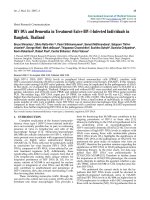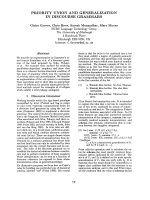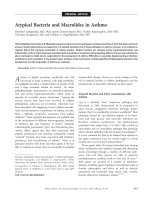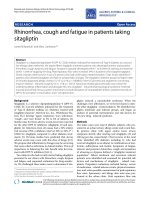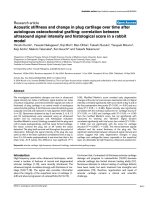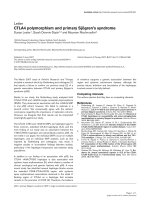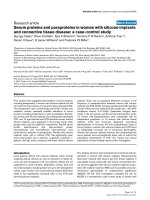Báo cáo y học: "Transcriptional (dys)regulation and aging in Caenorhabditis elegans" doc
Bạn đang xem bản rút gọn của tài liệu. Xem và tải ngay bản đầy đủ của tài liệu tại đây (120.64 KB, 4 trang )
Genome
BBiioollooggyy
2008,
99::
233
Minireview
TTrraannssccrriippttiioonnaall ((ddyyss))rreegguullaattiioonn aanndd aaggiinngg iinn
CCaaeennoorrhhaabbddiittiiss eelleeggaannss
Zachary Pincus and Frank J Slack
Address: Department of Molecular, Cellular and Developmental Biology, Yale University, New Haven, CT 06520, USA.
Correspondence: Frank J Slack. Email:
AAbbssttrraacctt
A circuit of transcription factors has been discovered in
Caenorhabditis elegans
that could
provide a link between laboratory-defined intracellular ‘longevity pathways’, gene dysregulation
and the process of normal aging.
Published: 16 September 2008
Genome
BBiioollooggyy
2008,
99::
233 (doi:10.1186/gb-2008-9-9-233)
The electronic version of this article is the complete one and can be
found online at />© 2008 BioMed Central Ltd
The fact that single-gene mutations can prolong an
organism’s lifespan might seem unlikely, but many ‘geronto-
genes’ have been identified in model organisms that, when
knocked out or over- or underexpressed, increase or decrease
lifespan in the laboratory environment. These genes largely
assort into several now-familiar pathways [1,2], many of
which converge on the insulin/insulin-like growth factor I
(IGF-I) signaling pathway, which in Caenorhabditis elegans
includes daf-2, an insulin/IGF-I receptor homolog; age-1,
which encodes a phosphatidylinositol 3-OH kinase (PI3K) at
the top of the DAF-2-activated signaling cascade; and daf-
16, a forkhead-family transcription factor that is inactivated
by this cascade. Nevertheless, it is unclear whether the
activities of these ‘longevity pathways’ are modulated during
normal aging, and as such, their role in the process of
senescent decline in wild-type individuals is uncertain.
Several pathways with longevity phenotypes in knockout
animals may not be relevant to normal aging; these include
the insulin/IGF-1 pathway, the endoplasmic reticulum stress
response mediated by the sirtuin SIR-2.1, and mitochondrial
electron transport [3]. Because of this, many researchers in
the field suspect that aging is primarily driven by
accumulation of cellular damage and not age-related gene
(dys)regulation.
In a recent paper in Cell [3], however, Yelena Budovskaya
and colleagues in the labs of Stuart Kim and Tom Johnson
have identified a circuit of GATA transcription factors that
alters C. elegans longevity when knocked out or knocked
down, and which also plays a role in regulating the changes
in gene expression observed during normal aging. Moreover,
this circuit helps determine lifespan. One of these factors,
ELT-3, is required for the pro-longevity effects of reduced
insulin/IGF-I-like signaling and dietary restriction,
providing at last a potential link between these longevity
pathways and the normal process of aging.
Budovskaya et al. [3] found that expression of the GATA-
family transcription factor genes elt-5 and elt-6, which act
during the embryonic development of the hypodermis (the
nematode epidermis) [4], gradually increases during aging.
The factors ELT-5 and ELT-6 act to downregulate the
expression of elt-3, another GATA transcription factor
involved in hypodermal differentiation [5,6] (Figure 1). Half
of the genes found to change expression during nematode
aging have conserved GATA motifs, and Budovskaya et al.
showed that 12 out of the 14 such genes they tested are
indeed under the control of elt-3. Moreover, RNA inter-
ference (RNAi) against elt-5 or elt-6 increases longevity in an
elt-3-dependent manner, demonstrating that this pathway
has causal control over at least some lifespan-determining
factors. Lastly, elt-3 RNAi largely suppresses the long-
lifespan phenotype of mutations in both daf-2 and eat-2
animals (these mutants are deficient in feeding, and are thus
a model of dietary-restriction-induced longevity), hinting
that the elt-3/elt-5/elt-6 circuit may modulate the effects of
the insulin/IGF-1 pathway and calorie intake on lifespan.
DDrriivviinngg tthhee aaggiinngg pprroocceessss
To seek out potential drivers of age-related changes in gene
expression, Budovskaya et al. [3] carried out microarray
studies in C. elegans at 4, 7, 10, and 14 days of adulthood,
finding 1,254 genes that change expression during aging. (By
and large, gene expression decreases in older animals - a
general pattern similar to that seen in human subjects [7].)
Microarray studies of aging nematodes have been carried
out previously (for reviews, see [8,9]), with results largely
consistent with the current study. However, instead of
simply categorizing the genes identified, Budovskaya et al.
then looked for common patterns of transcriptional control.
As in other work (for example, in C. elegans [10] and yeast
[11]), computational techniques were brought to bear on the
identification of DNA sequence motifs enriched in the
regions upstream of genes suspected to be co-regulated.
Using the CompareProspector tool, which minimizes false
positives by looking for motifs with evolutionary conser-
vation [12], the investigators found conserved GATA motifs
upstream of approximately half of the genes that change
expression with age.
The authors also found that GATA motifs were enriched in
genes identified by previous aging microarray studies [13]
and in genes identified by microarray analyses of
mutations in the insulin/IGF-I pathway. Somewhat
surprisingly, the overall trend that emerged from this
analysis is that long-lived insulin/IGF-I pathway mutants
(which have a salubrious increase in DAF-16 activity) have
gene-expression patterns similar to those of old animals,
whereas gene-expression patterns in daf-16 mutants tend
towards those in young animals. We hope that this,
perhaps counterintuitive, result, which has now been
replicated by two aging time-courses [13], will provoke
future studies.
Budovskaya et al. [3] then selected 10 of the 14 known C.
elegans GATA transcription factors to examine for potential
longevity phenotypes. RNAi knockdowns of these yielded no
longevity phenotype; however, three factors - ELT-3, EGR-1
and EGL-27 - were shown to suppress the phenotype of a daf-
2 mutant, indicating that, although their loss does not impair
lifespan in lab conditions, they are required for the lifespan-
prolonging effects of decreased insulin/IGF-I signaling.
Furthermore, knockdown of ELT-3 also suppresses the
longevity of the feeding-deficient eat-2 mutant, suggesting a
second longevity pathway that requires ELT-3. (The dietary-
restriction-induced longevity of eat-2 does not require active
DAF-16 and is additive with daf-2 mutations, indicating that
these pathways are independent [14].)
The authors then examined several of the 602 age-regulated,
conserved-GATA-bearing genes they had identified and
confirmed that the majority of those examined were
downstream targets of elt-3; furthermore, all genes so
examined were regulated via the GATA sites in their
promoter regions. Together, these data indicate that elt-3 is
indeed a regulator of several of age-related genes; further
studies to establish whether elt-3 plays a role in the regula-
tion of the remaining age-modulated genes may prove
enlightening.
RReegguullaattiinngg tthhee rreegguullaattoorrss
Although elt-3 was not among the age-regulated genes
identified by Budovsakaya et al. [3] in their microarray experi-
ment, they found that an elt-3::GFP reporter shows an age-
related decline in expression, indicating that perhaps the
decline in elt-3 expression is responsible for driving some
portion of the age-related decline in overall gene expression -
overexpression of elt-3 may thus provide several interesting
phenotypes. As a next step, the authors sought to identify the
upstream regulator of elt-3 responsible for its age-related
decline. RNAi experiments showed that age-1 (and by
implication, the insulin/IGF-I pathway) exerts a negative
control over the expression of elt-3; this regulation was
independent of age, however. One theory of aging holds that
senescent decline is driven by accumulation of damage from a
lifetime of endogenous and environmental stressors (see, for
example [15-18]); perhaps, therefore, stressors such as heat
shock, oxidation, DNA damage or bacterial infection might
downregulate elt-3? As it happens, the answer is no:
Budovskaya et al. [3] did not find evidence for this hypothesis.
Another theory of aging notes that as organisms age toward
a post-reproductive phase, the force of natural selection
weakens. Thus, alleles that have beneficial early-life but
detrimental late-life phenotypes can be evolutionarily
advantageous, and genes that are silenced after a certain
/>Genome
BBiioollooggyy
2008, Volume 9, Issue 9, Article 233 Pincus and Slack 233.2
Genome
BBiioollooggyy
2008,
99::
233
FFiigguurree 11
Crossed signals? During development, the
elt-3/elt-5/elt-6
transcriptional
circuit guides cell-fate determination in the hypodermis. During
adulthood, however, ELT-3 activity appears necessary for stress
responses (and for the lifespan-prolonging effects of dietary restriction),
and is repressed by insulin/IFG-I-like signaling. As individual
C. elegans
age,
however, expression of
elt-5
and
elt-6
drifts upward. This drift reduces
lifespan by decreasing the levels of ELT-3.
ELT-5
ELT-6
elt-3
Developmental
context
Old age
Times of plenty
(insulin/IGF-I-like
signaling active)
Hypodermal differentiation
(non-seam-cell identity)
Pro-longevity factors
(stress responses?)
Lean times
(for example,
dietary
restriction)
elt-3/elt-5/elt-6
transcriptional circuit
developmental stage may become derepressed later in life
[19]. During development, elt-3, which itself has GATA
motifs in its promoter region, is regulated by several other
GATA factors: elt-1, a positive regulator of elt-3 [5]; and elt-5
and elt-6, which are negative regulators [4]. As such, antago-
nistic pleiotropy theories of aging suggest that this
transcriptional circuit may become dysregulated in aging
animals in a way that is immune to the effects of natural
selection. Indeed, Budovskaya et al. [3] found tantalizing
evidence for age-related dysregulation of the elt circuit. For
one thing, the expression of elt-5 and elt-6, which are
downregulated at the beginning of adulthood, drifts upward
with time. Moreover, RNAi against these factors in adult C.
elegans prevents much of the age-related decline in elt-3
expression. Another piece of evidence is the fact that such
RNAi substantially prolongs lifespan compared with wild-
type animals, and does so in an elt-3-dependent manner. As
expected by antagonistic pleiotropy theories of aging, RNAi
against elt-5 and elt-6, while lifespan-extending in older
animals, is detrimental in younger ones.
OOlldd aanndd oouutt ooff ccoonnttrrooll??
What, then, drives senescence in elderly animals? Do the parts
simply wear out, or is gene dysregulation to blame? Many
genes in well-known longevity pathways such as insulin/IGF-I
signaling, mitochondrial oxygen transport, or the response to
dietary restriction seem to be involved in modulating
physiological stress responses [2,20]. Indeed, the ability to
mobilize an effective heat-shock response is a potent marker
for the eventual longevity of an individual C. elegans [21].
These and other observations [15] augur well for the
damage-accumulation view of aging, in which stress-
response and damage repair are key to lifespan extension.
On the other hand, the lack of a well-defined role for these
pathways in normal aging, despite intensive investigation, is
most curious. The identification by Budovskaya et al. of age-
related transcriptional (dys)regulation, in a protein required
for various lifespan-prolonging interventions, certainly
suggests that antagonistic pleiotropy may play a significant
part in aging.
Several observations in this work, however, suggest that
these two views on aging need not be mutually exclusive.
First, the authors note that the long lifespan of daf-2
mutants (insulin/IGF-I signaling deficient) and eat-2
mutants (feeding deficient) both require expression of elt-3.
These pathways are generally thought to be genetically
independent [14], so any common thread must be fairly far
downstream, perhaps in the stress-response pathways. This
suggests that future experiments to identify more closely the
positions of elt-3, elt-5, and elt-6 in these genetic pathways
will be most informative. One perspective on the insulin/
IGF-I pathway is that it serves to repress the stress response
in times of plenty [20]; thus, repression of elt-3 by insulin/
IGF-I signaling is consistent with a role for that gene in
stress responses. The similarity of gene-expression patterns
in old age (after accumulation of many cellular stressors)
and those in insulin/IGF-I signaling deficient mutants (with
derepressed stress responses) may also be telling. (A
comparison of stress-regulated and aging-related genes
would be illuminating on this point.) Finally, Budovskaya et
al. [3] observe that elt-3-null C. elegans are more sensitive
to heat shock and oxidative stress than are wild-type
animals, whereas elt-5 RNAi (which increases the level of
elt-3) causes a slight stress resistance. If elt-3 were involved
in regulating stress responses, its downregulation later in life
(through dysregulation of elt-5 and elt-6 levels) might lead
to impairment of damage repair and decreased longevity.
Although theoretical arguments have suggested that
antagonistic pleiotropy is most likely to appear in regulators
of stress-response and damage-repair pathways [22], this
work may be the first demonstration of that principle.
RReeffeerreenncceess
1. Antebi A:
GGeenneettiiccss ooff aaggiinngg iinn
CCaaeennoorrhhaabbddiittiiss eelleeggaannss
PLoS Genet
2007,
33::
1565-1571.
2. Houthoofd K, Vanfleteren JR:
PPuubblliicc aanndd pprriivvaattee mmeecchhaanniissmmss ooff lliiffee
eexxtteennssiioonn iinn
CCaaeennoorrhhaabbddiittiiss eelleeggaannss
Mol Genet Genomics
2007,
227777::
601-617.
3. Budovskaya YV, Wu K, Southworth LK, Jiang M, Tedesco P, Johnson
TE, Kim SK:
AAnn
eelltt 33//eelltt 55//eelltt 66
GGAATTAA ttrraannssccrriippttiioonn cciirrccuuiitt gguuiiddeess
aaggiinngg iinn
CC eelleeggaannss
Cell
2008,
113344::
291-303.
4. Koh K, Rothman JH:
EELLTT 55 aanndd EELLTT 66 aarree rreeqquuiirreedd ccoonnttiinnuuoouussllyy ttoo
rreegguullaattee eeppiiddeerrmmaall sseeaamm cceellll ddiiffffeerreennttiiaattiioonn aanndd cceellll ffuussiioonn iinn
CC
eelleeggaannss
Development
2001,
112288::
2867-2880.
5. Gilleard JS, McGhee JD:
AAccttiivvaattiioonn ooff hhyyppooddeerrmmaall ddiiffffeerreennttiiaattiioonn iinn
tthhee
CCaaeennoorrhhaabbddiittiiss eelleeggaannss
eemmbbrryyoo bbyy GGAATTAA ttrraannssccrriippttiioonn ffaaccttoorrss
EELLTT 11 aanndd EELLTT 33
Mol Cell Biol
2001,
2211::
2533-2544.
6. Gilleard JS, Shafi Y, Barry JD, McGhee JD: ELT-3:
AA
CCaaeennoorrhhaabbddiittiiss
eelleeggaannss
GGAATTAA ffaaccttoorr eexxpprreesssseedd iinn tthhee eemmbbrryyoonniicc eeppiiddeerrmmiiss dduurriinngg
mmoorrpphhooggeenneessiiss
Dev Biol
1999,
220088::
265-280.
7. Tan Q, Zhao J, Li S, Christiansen L, Kruse TA, Christensen K:
DDiiffffeerr
eennttiiaall aanndd ccoorrrreellaattiioonn aannaallyysseess ooff mmiiccrrooaarrrraayy ggeennee eexxpprreessssiioonn ddaattaa iinn
tthhee CCEEPPHH UUttaahh
ffaammiilliieess
Genomics
2008,
9922::
94-100.
8. Golden TR, Melov S:
GGeennee eexxpprreessssiioonn cchhaannggeess aassssoocciiaatteedd wwiitthh aaggiinngg
iinn
CC eelleeggaannss
((FFeebbrruuaarryy 1122,, 22000077))
. In
WormBook
, edited by The
C.
elegans
Research Community, WormBook [m-
book.org]
9. Melov S, Hubbard A:
MMiiccrrooaarrrraayyss aass aa ttooooll ttoo iinnvveessttiiggaattee tthhee bbiioollooggyy
ooff aaggiinngg:: aa rreettrroossppeeccttiivvee aanndd aa llooookk ttoo tthhee ffuuttuurree
Sci Aging Knowl
Environ
2004:re7
10. Gaudet J, Muttumu S, Horner M, Mango SE:
WWhhoollee ggeennoommee aannaallyyssiiss
ooff tteemmppoorraall ggeennee eexxpprreessssiioonn dduurriinngg ffoorreegguutt ddeevveellooppmmeenntt
PLoS Biol
2004,
22::
e352.
11. Harbison CT, Gordon DB, Lee TI, Rinaldi NJ, Macisaac KD, Danford
TW, Hannett NM, Tagne JB, Reynolds DB, Yoo J, Jennings EG,
Zeitlinger J, Pokholok DK, Kellis M, Rolfe PA, Takusagawa KT,
Lander ES, Gifford DK, Fraenkel E, Young RA:
TTrraannssccrriippttiioonnaall rreegguu
llaattoorryy ccooddee ooff aa eeuukkaarryyoottiicc ggeennoommee
Nature
2004,
443311::
99-104.
12. Liu Y, Liu XS, Wei L, Altman RB, Batzoglou S:
EEuukkaarryyoottiicc rreegguullaattoorryy
eelleemmeenntt ccoonnsseerrvvaattiioonn aannaallyyssiiss aanndd iiddeennttiiffiiccaattiioonn uussiinngg ccoommppaarraattiivvee
ggeen
noommiiccss
Genome Res
2004,
1144::
451-458.
13. Lund J, Tedesco P, Duke K, Wang J, Kim SK, Johnson TE:
TTrraannssccrriipp
ttiioonnaall pprrooffiillee ooff aaggiinngg iinn
CC eelleeggaannss
Curr Biol
2002,
1122::
1566-1573.
14. Lakowski B, Hekimi S:
TThhee ggeenneettiiccss ooff ccaalloorriicc rreessttrriiccttiioonn iinn
CCaaeennoorrhhaabbddiittiiss eelleeggaannss
Proc Natl Acad Sci USA
1998,
9955::
13091-13096.
15. Rattan SI:
IInnccrreeaasseedd mmoolleeccuullaarr ddaammaaggee aanndd hheetteerrooggeenneeiittyy aass tthhee bbaassiiss
ooff aaggiinngg
Biol Chem
2008,
338899::
267-272.
16. Golden TR, Hinerfeld DA, Melov S:
OOxxiiddaattiivvee ssttrreessss aanndd aaggiinngg::
bbeeyyoonndd ccoorrrreellaattiioonn
Aging Cell
2002,
11::
117-123.
17. Herndon LA, Schmeissner PJ, Dudaronek JM, Brown PA, Listner KM,
Sakano Y, Paupard MC, Hall DH, Driscoll M:
SSttoocchhaassttiicc aanndd ggeenneettiicc
ffaaccttoorrss iinnfflluueennccee ttiissssuuee ssppeecciiffiicc ddeecclliinnee iinn aaggeeiinngg
CC eelleeggaannss
Nature
2002,
441199::
808-814.
/>Genome
BBiioollooggyy
2008, Volume 9, Issue 9, Article 233 Pincus and Slack 233.3
Genome
BBiioollooggyy
2008,
99::
233
18. Gerstbrein B, Stamatas G, Kollias N, Driscoll M:
IInn vviivvoo
ssppeeccttrroofflluuoo
rriimmeettrryy rreevveeaallss eennddooggeennoouuss bbiioommaarrkkeerrss tthhaatt rreeppoorrtt hheeaalltthhssppaann aanndd
ddiieettaarryy rreessttrriiccttiioonn iinn
CCaaeennoorrhhaabbddiittiiss eelleeggaannss
Aging Cell
2005,
44::
127-
137.
19. Martin GM:
MMooddaalliittiieess ooff ggeennee aaccttiioonn pprreeddiicctteedd bbyy tthhee ccllaassssiiccaall eevvoo
lluuttiioonnaarryy bbiioollooggiiccaall tthheeoorryy ooff aaggiinngg
Ann NY Acad Sci
2007,
11110000::
14-
20.
20. Johnson TE, Henderson S, Murakami S, de Castro E, de Castro SH,
Cypser J, Rikke B, Tedesco P, Link C:
LLoonnggeevviittyy ggeenneess iinn tthhee nneemmaa
ttooddee
CCaaeennoorrhhaabbddiittiiss eelleeggaannss
aallssoo mmeeddiiaattee iinnccrreeaasseedd rreessiissttaannccee ttoo
ssttrreessss aanndd pprreevveenntt ddiisseeaassee
J Inherit Metab Dis
2002,
2255::
197-206.
21. Rea SL, Wu D, Cypser JR, Vaupel JW, Johnson TE:
AA ssttrreessss sseennssiittiivvee
rreeppoorrtteerr pprreeddiiccttss lloonnggeevviittyy iinn iissooggeenniicc ppooppuullaattiioonnss ooff
CCaaeennoorrhhaabbddiittiiss
eelleeggaannss
Nat Genet
2005,
3377::
894-898.
22. Clark WR:
RReefflleeccttiioonnss oonn aann uunnssoollvveedd pprroobblleemm ooff bbiioollooggyy:: tthhee eevvoolluu
ttiioonn ooff sseenneesscceennccee aanndd ddeeaatthh
Adv Gerontol
2004,
1144::
7-20.
/>Genome
BBiioollooggyy
2008, Volume 9, Issue 9, Article 233 Pincus and Slack 233.4
Genome
BBiioollooggyy
2008,
99::
233
